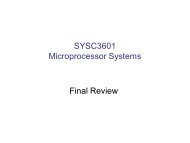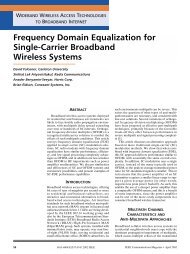Image Reconstruction for 3D Lung Imaging - Department of Systems ...
Image Reconstruction for 3D Lung Imaging - Department of Systems ...
Image Reconstruction for 3D Lung Imaging - Department of Systems ...
You also want an ePaper? Increase the reach of your titles
YUMPU automatically turns print PDFs into web optimized ePapers that Google loves.
where �r is a position vector within element k. For an inhomogenous isotropic material<br />
σk(˜r) is a conductivity tensor <strong>of</strong> the <strong>for</strong>m σk(˜r) = σk(˜r)I where ˜r is a scalar function <strong>of</strong> the<br />
conductivity and I is the identity matrix.<br />
In [77] Kaipo et al use the same linear basis functions, wi, <strong>for</strong> σ as are used <strong>for</strong> the<br />
potential. In [77] the authors do not discuss or exploit the complexity improvement associated<br />
with using the nodal basis. Their use <strong>of</strong> piecewise linear conductivity was motivated<br />
by a requirement to calculate the gradient <strong>of</strong> the conductivity within each element <strong>for</strong> the<br />
purposes <strong>of</strong> incorporating a structural prior into their reconstructions. By using a piecewise<br />
linear conductivity model the gradient over each element is a constant. An implementation<br />
<strong>of</strong> the piecewise linear element is available in the EIDORS2D toolset [116] in which Y is<br />
calculated from equation 5.11. Also provided is a function to calculate the corresponding<br />
Nodal Jacobian using the Standard Method.<br />
EIDORS<strong>3D</strong> [93] calculates an Elemental Jacobian using the NSHI (nullspace scaled<br />
hybrid isotropic) algorithm described in [121]. The NSHI algorithm is over 60 times faster<br />
than the Standard Method <strong>for</strong> the example cited in [98] but requires components calculated<br />
from an element based master matrix. Thus in order to retain the speed advantage <strong>of</strong> the<br />
NSHI algorithm, we adapted the EIDORS2D nodal master matrix construction algorithm<br />
to construct a Nodal Jacobian, H N , from the elemental Jacobian, H E , as follows:<br />
1 d = 3 <strong>for</strong> triangles or d = 4 <strong>for</strong> tetrahedrons<br />
2 <strong>for</strong> each node, n, in the mesh<br />
3 elems=list <strong>of</strong> elements using node n<br />
�<br />
=<br />
4 H N :,n<br />
i∈elems<br />
5 end <strong>for</strong> each node<br />
1/dH E :,i where H:,i means the i th column <strong>of</strong> matrix H.<br />
Intuitively this can thought <strong>of</strong> as having each element contribute an equal proportion <strong>of</strong> its<br />
sensitivity to each <strong>of</strong> its three or four contained vertices.<br />
When using the Nodal Jacobian in the regularized inverse 5.6 the resulting solution will<br />
be in the nodal basis. It is possible to convert the nodal solution back to a piecewise constant<br />
element basis where it is determined by E parameters. Conversion back to an elemental<br />
basis can be done by setting the conductivity value <strong>for</strong> each element to an average <strong>of</strong><br />
the conductivity values <strong>of</strong> its enclosing vertices. This has the advantage <strong>of</strong> being simple<br />
to implement and works well <strong>for</strong> meshes constructed <strong>of</strong> regularly spaced nodes. It is also<br />
possible to weigh the average as a function <strong>of</strong> subtended angle or Voronoi cell area. In either<br />
case the conversion to an elemental solution will introduce additional smoothing through<br />
local averaging which may or may not be desirable. In this paper we maintain solutions in<br />
the nodal basis.<br />
Two advantages <strong>of</strong> the nodal basis are the ability to store the solution in a smaller<br />
number <strong>of</strong> parameters, and the ability to rapidly extract and render graphical displays <strong>of</strong><br />
solutions using a function such as Matlab’s built-in trisurf function. The trisurf function<br />
takes as input a list <strong>of</strong> vertices and associated values at each vertex. No explicit knowledge<br />
<strong>of</strong> the geometry is required, such as an element list providing connectedness between nodes,<br />
in order to display cut planes <strong>of</strong> coplanar nodes. For example the <strong>3D</strong> model <strong>of</strong> figure 5.1(a)<br />
has coplanar nodes at each <strong>of</strong> its 29 nodal layers as well as coplanar nodes at vertical slices<br />
such as x = 0 and y = 0 and other angles. Figure 5.7(a) shows three multiplane conductivity<br />
representations <strong>of</strong> figure 5.1(b) that were rendered by trisurf in real time (60ms each).<br />
67





